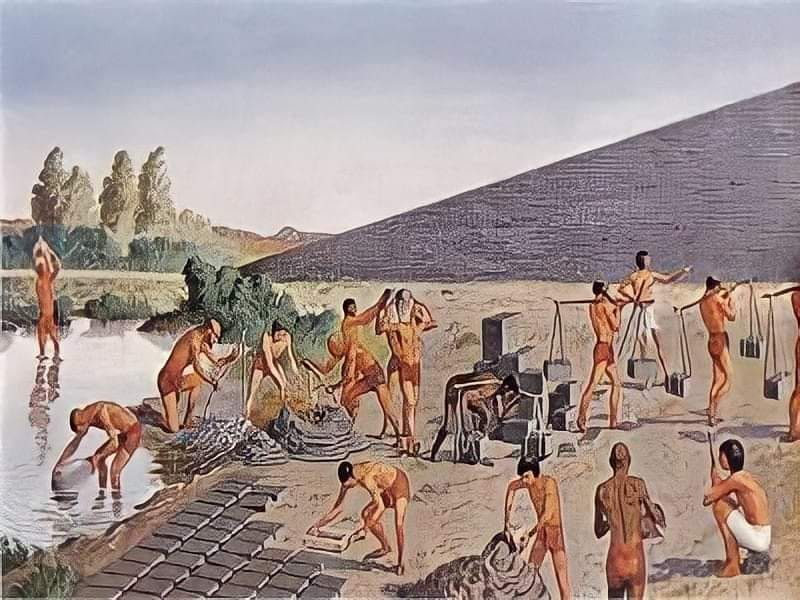«Workers in ancient Egypt»

Let us take a tour of ancient Egypt, where Egyptian society was divided into classes. Wilson considered Egyptian society to consist of a pyramid with a separate pyramid on top representing the king, followed by the upper class, which contained “the minister, the governors of the provinces, and the priests,” then the middle class, which contained junior employees, merchants, and those with excellent crafts. “From artists and craftsmen,” then the lower class, “which includes merchants working in internal trade, workers, and peasants.”
We come to enrich our topic, which concerns “workers.”
The most famous of them are those who work in mines and quarries and in building pyramids, tombs and temples. The state supervised the workers through foremen and inspectors and transported them, under the protection of soldiers, to the workplace. They were divided into teams, each team bearing a specific name. There were those who registered the names of the workers and inspectors who passed by daily and weekly.
Workers’ housing was found in the Al-Ahram area, which consisted of long, narrow halls numbering one hundred, each one accommodating approximately fifty workers. They were guaranteed food and clothing, and perhaps they were happier than the peasants.
Workers' village
A small village near the area now called Deir al-Medina, which was called the House of Truth, and its workers were called “those who work in the place of truth,” and they were the group of workers specialized in building and engraving the tombs of the kings. They considered their work extremely important. The village was surrounded by a thick wall made of mud, on which it was found. Cartouches of King Tuthmosis I, meaning that the village dates back to the beginning of the Eighteenth Dynasty. The number of houses discovered in the village was about seventy houses, divided equally on both sides of a road extending from north to south. The houses were adjacent to one another, and each house shared a wall with the neighboring house, and there were no spaces between the houses. Some houses were built outside the village wall, and a court was found in the village, all of whose members were from the villagers, to settle disputes among the people. It had the right to impose penalties and punishment on the accused and pardon those who were acquitted. As for the death penalty, it had to be referred to the minister, who also had the right to pardon the accused.
Division of workers
They form a squad divided into two groups: the first, the right-handed group, works on the right side of the tomb, and the left-handed group works on the left side. The number of workers in the squad is about 60 workers, and this number increased to double during the reign of Ramesses IV.
The team was supervised by two foremen for each group, a leader, and under each leader was an agent who assisted him, then a clerk responsible for the administrative aspect of the workers’ group kept a special diary in which he recorded the names of workers absent from work, determined the reasons for the absence, recorded everything important related to the work, and submitted his reports to The minister or royal delegate who visits the cemetery from time to time to follow up on what has been done there.
Workers' tools
Copper tools were distributed to them and then retrieved from them when they lost their sharpness in order to be remanufactured again. The weight of each piece and the name of the worker who received it was recorded, and a piece of stone of the same weight was placed with a card bearing the name of the worker who received it from the responsible clerk. ; They had with them lighting lamps made of burnt clay, filled with vegetable oil, and containing a wick made from worn rags, delivered by the supervisor of the Pharaoh’s storeroom located near the tomb. The writer recorded daily the number of wicks distributed, and sometimes he recorded what was distributed in the morning and afternoon, which indicates that the work was divided into two periods, with a break for lunch. The number of wicks varied according to the size of the tomb and the number of workers. The ancient Egyptian came up with a way to exclude the rising cymbals from the lamp so as not to distort the beauty of the tomb. Scenery .
Work and vacation system
Work continues throughout the year and the worker is granted three days of leave per month (the tenth, twenty-thirtieth day); According to the ancient Egyptians, the month was divided into three periods, each period of ten days, with the tenth day being a holiday, and the days of the feasts of the major deities in the country were added to the holidays.
Workflow
It begins with excavation, then the walls of the tomb are covered after excavation with gypsum to draw on. The drawing is done first in red, then the correction in black. The engravers then engrave, whether raised or recessed, and the work continues according to the size of the tomb.
Workers' situation
The nobles indicated in their monuments that they paid wages to the workers and artists who carved their monuments, and that these workers were satisfied with the wages. In the New Kingdom, the texts indicated an improvement in the conditions of workers in the era of the New Kingdom, represented by the workers of the Deir el-Medina area.
But at the end of the Ramesside era, beginning with the era of Ramesses III, a set of documents reached us dealing with the delay in salaries paid to workers due to an economic crisis that the country went through, in addition to the dishonesty of some employees, which made the government fail to extend the workers of Deir el-Medina their allowances, and this matter led to the first strike in history. .
Source: websites

